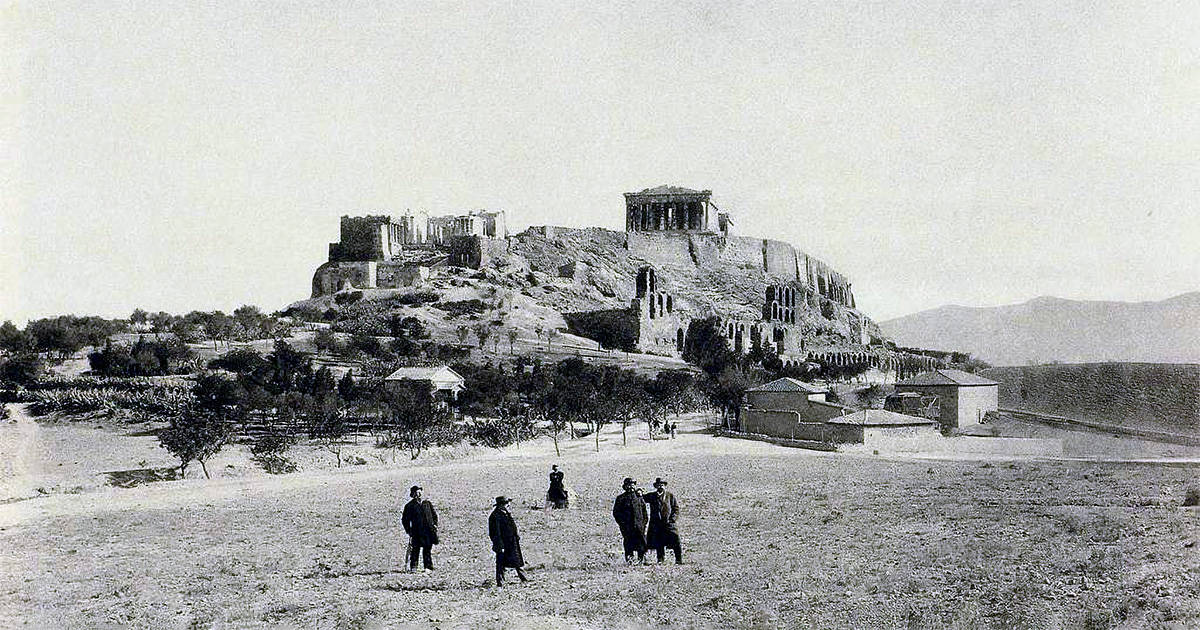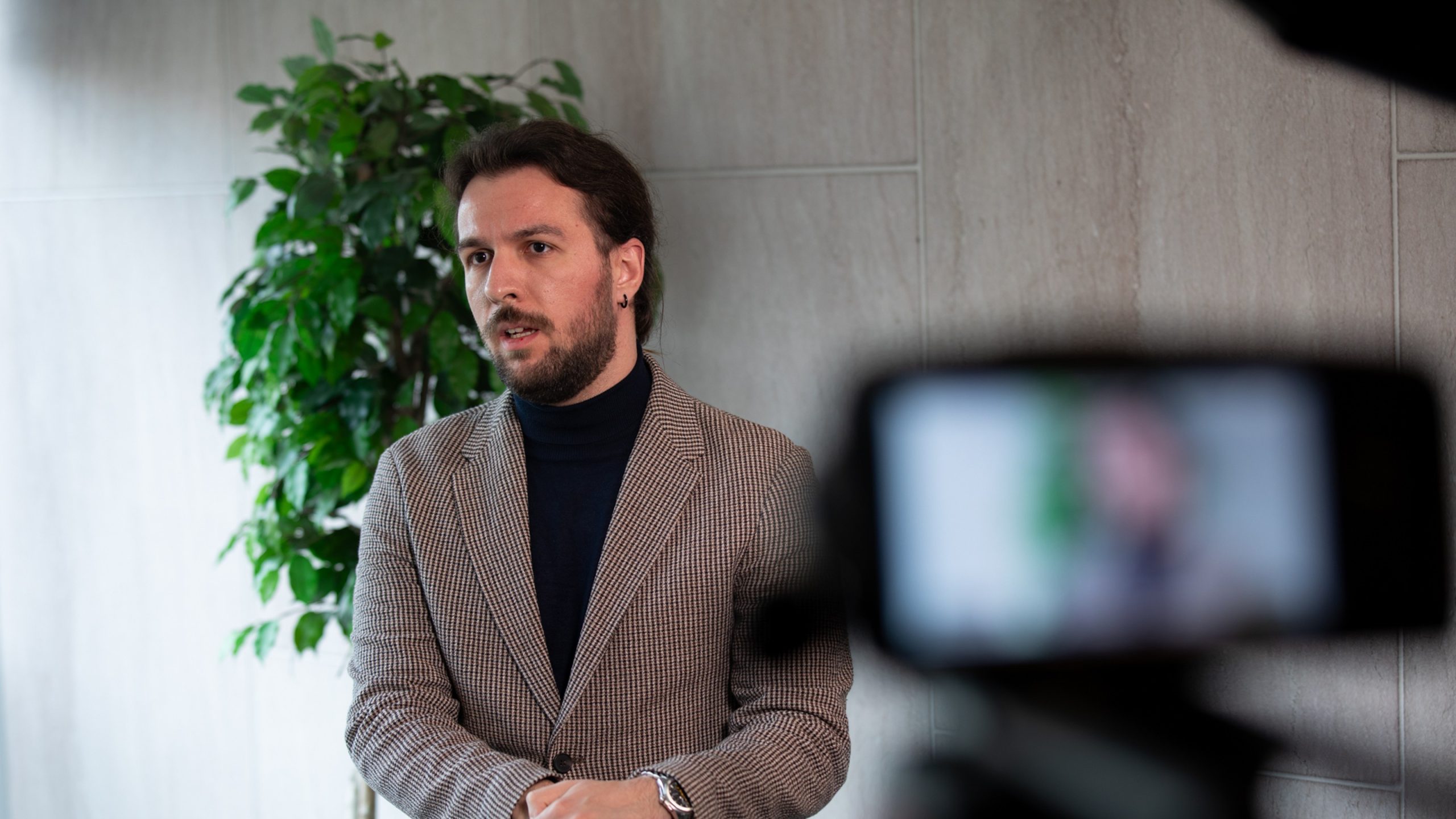“However, Lanthimos did not seek to ‘desecrate’ but rather to find a ‘womb’ for his post-apocalyptic rebirth, a space for catharsis where life, with cats wandering indifferently, transcends death. What may not have been appreciated is the transformation of the Acropolis from a symbol of glory to a scene of remembrance, a scene of transformation not through sanctity but through the fragments that will give birth to the new.”
Sacred symbol or political stage?
It was there, at the end of spring, that Greece and the Athenians found themselves looking at the Acropolis with a different view than usual – and that’s because something had changed. In May 2025, in the Athenian sky, a show of Adidas drones suddenly made its appearance, a giant sneaker sleeping, creating a sense of ‘oppression’ of the Parthenon beneath its sole. Following the reaction the following morning after the show, the Minister of Culture – under the weight of criticism – Lina Mendoni, described the image as ‘extremely unpleasant’ and announced legal action against those responsible.
Not long before, the same Minister had rejected the request of the internationally renowned Greek director Yorgos Lanthimos to film scenes of his new film ‘Bugonia’ on the Acropolis. The Central Archaeological Council (KAS) ruled that the proposed scenes with 70 artificial corpses were ‘incompatible with the symbolism and values represented by the Acropolis.
However, Lanthimos did not seek to ‘desecrate’ but rather to find a ‘womb’ for his post-apocalyptic rebirth, a space for catharsis where life, with cats wandering indifferently, transcends death. What may not have been appreciated is the transformation of the Acropolis from a symbol of glory to a scene of remembrance, a scene of transformation not through sanctity but through the fragments that will give birth to the new.
After all, the sacred ancient temples were not used by art only for triumphs. Consider Lucretius seeking the permission of the Central Archaeological Council to include in De Rerum Natura their images where the plague of Athens leaves behind bodies rotting in temples, sanctuaries that no longer offer comfort. The Acropolis, albeit silently, hovers in this narrative as a place where life and death coexist, without divine salvation. If in Lanthimos’ work decay conceals a new beginning, in Lucretius it is the final reminder that everything, even sacred things, obeys the laws of nature.
In both cases, salvation does not come from the gods, but from matter; either through the inanimate giving life back to the living (in Lanthimos’ imagination), or through the sober assumption that everything obeys the laws of nature. Perhaps, in the end, the Acropolis was not deemed ‘inappropriate’ because of the content of the scene, but because the proposal itself dared to challenge the dominant narrative about the national shrine; to see it not as a sanctuary, but as a field of reflection on death, memory and rebirth, in a city that is a palimpsest.
In a way, these two incidents revealed the contradictions within contemporary Greek cultural policy. On one hand, there is the commercial exploitation of the Parthenon for promotional purposes — though, to be fair, the flight and landing did not take place directly on the Acropolis. Still, they ‘abused’ an area subject to legal restrictions on building height, designed to ensure that the conspectus publicus — the public view of the Acropolis — remains unobstructed.
On the other hand, the same monument is zealously shielded from artistic interpretations considered “inappropriate” or at odds with the dominant national narrative of how the Parthenon ought to be viewed. Ultimately, the Parthenon is not just an ancient ruin — it is a contested arena where questions of national identity, cultural heritage, and political power are continuously negotiated.
Greece’s Ministry of Culture has reacted negatively to a drone light show by popular sports brand #Adidas to promote its brand and appears to have utilized the #Acropolis as a backdrop. Full story: https://t.co/CTSzxFt9iE pic.twitter.com/oVhkYj3yvj
— Greek Reporter (@GreekReporter) May 16, 2025
Archaeopolitics and the continuity
Parthenon, therefore, functions as a tool of “archaeopolitics”, i.e. as a means of political governance of antiquity for the formation of national narratives with the consequent social participation of specific groups or the exclusion of others. Which narratives are allowed and which are silenced, does the Parthenon ultimately have inheritors?
The monument, which was a symbol of the Athenian Republic in the 5th century BC, centuries later and with history passing over it, was transformed in the 19th century into one of the most charged pillars of modern Greek national identity. It was not always the pure, white monument we know it to be, and it is our main source of reading about the ancient past. From the 6th century AD onwards, it went from Christian temple, to mosque, to ammunition depot, and finally to ruin (?) But the question is, when did it become Greece’s national totem?

Athens and the Acropolis in late 19th century. Credit: Public Domain
After the establishment of the Greek state in 1830, Greece was built on the assumption of ‘continuity’ between ancient and modern Greeks. The Parthenon was the symbolic foundation of this continuity, embodied in the marbles of the temple. The cleansing of the rock of the Acropolis from its Ottoman and Byzantine layers was done in the name of a ‘restoration’ of the classical past, when in fact what was attempted was the cultural cleansing of any element that did not substantiate the national narrative.
Although Athens, was not the first capital of the then newly established state, the monument’s powerful geomorphological position, its confessed role and symbolism in classical times, as well as the tradition of viewing the classical and the subsequent phase – their first contact was rather episodic – of recognition by the British of the monument’s artistic value, led to its selection as a national emblem where history is the bullhorn and the monument the seal to confirm the historical legitimacy of the modern nation-state, affirming that material culture is not part of history but a means of power and cultural hierarchy.
“After the establishment of the Greek state in 1830, Greece was built on the assumption of ‘continuity’ between ancient and modern Greeks. The Parthenon was the symbolic foundation of this continuity, embodied in the marbles of the temple. The cleansing of the rock of the Acropolis from its Ottoman and Byzantine layers was done in the name of a ‘restoration’ of the classical past, when in fact what was attempted was the cultural cleansing of any element that did not substantiate the national narrative.”
Reclaiming the ruins: resistance, belonging, and the right to memory
Therefore, we cannot read antiquity and its material remains as mere cultural fragments of a blurred – for many – past, but rather as political tools and even biopolitical tools for the imposition of specific standards, rules and narratives through antiquities. The Parthenon, from this perspective, is not only a monument, but also a ‘body’, a monument that imposes rules, regulates bodies and organises populations. In particular, its presence and its tropical representation in the public sphere produces a standard imaginative way of understanding it and, by implication, of providing specific rules such as who is entitled to touch it? Who is allowed to represent it? What aesthetic or political act is considered an ‘insult’?
The exclusion of Lanthimos from the Acropolis, for example, or demonstrates how the state, under the pretext of ‘protecting cultural heritage’, advocates a particular hegemonic narrative that is not open to questioning – this ‘antiquity worship’ translates into a rhetorical surveillance of belonging, according to Foucault’s biopolitical logic of who are ultimately ‘Greeks’, who ‘honour history’ and who are considered ‘enemies’ of the past in terms of their participation in the maintenance of this reading.
Thus, the Parthenon has become the monopoly of an ideological arena (sic) of the state for self-definition. From its illumination on national holidays to the prohibition of alternative readings, it constitutes a performative act in which antiquity ‘saves’ the nation from the crisis of the present.
📌Διεθνές μήνυμα αλληλεγγύης στον παλαιστινιακό λαό εκπέμπεται αυτή τη στιγμή από τον βράχο της Ακρόπολης.
🔴Με μια συντονισμένη κινητοποίηση, νωρίς το πρωί, μέλη του ΚΚΕ και της ΚΝΕ ανέβηκαν στην Ακρόπολη και σήκωσαν δύο πανό προς την πλευρά της Διονυσίου Αρεοπαγίτου, γραμμένα… pic.twitter.com/3uxvxbti8C— Οδηγητής (@odigitis) September 19, 2025
Despite the use of the Parthenon as a national totem, there are many instances where artists, activists and intellectuals reclaim the monument by proposing other, often disturbing, readings. These resistances challenge the supposed “purity” and unity of the Parthenon, revealing its deeply ideological and exclusive use. In 2022, at Athens Pride, LGBTQ+ activists held a banner with the slogan ‘History is also queer’, tapping into the documented – but often silenced – homoerotic dimension of ancient Greek society. A variety of studies reveal that the exclusive relationship of the Parthenon to the formation of Greek identity is part of a historical narrative; something like an umbilical cord of ideological survival. However, this ‘food’ leads to a deeply political habit of implicitly excluding people from the narrative such as immigrants, the poor, LGBTQA+ subjects, non-normative bodies (often associated with the deviation of the classical standard of beauty), and probably those who do not “fit” into the archetypal frame of ‘Greece of the ancestors’, but not all ancestors.
What else but natural through this would be to give rise to a plausible final question, of whose Parthenon is the Parthenon after all? Does it belong to the state? To the archaeologists? To the tourists? To the citizens who pay for its maintenance? Or, more fundamentally, to those who interpret it differently? The dispute over the ownership of the Parthenon is not only about the issue of the sculptures and their return from the British Museum. It is about something deeper, a need, a right to see and experience the monument through different lenses. To allow the Parthenon to be not only our national purgatory, but also a mirror of changing societies. And if we do not free it from its national monologue, then it will simply continue to be a ‘sacred space’ to which fewer and fewer people will feel they belong.
- Acropolis
- Adidas drone
- antiquity
- archaeology
- archaeopolitics
- artistic censorship
- Athens
- Athens Pride
- biopolitics
- classical Greece
- cultural heritage
- cultural policy
- exclusion
- Foucault
- Greek identity
- Hamilakis
- heritage politics
- historical continuity
- LGBTQ+ history
- material culture
- memory politics
- monument ownership
- national narrative
- national symbolism
- national totem
- Parthenon
- postcolonial critique
- protest art
- public space
- state ideology
- Yorgos Lanthimos
Written by
Shape the conversation
Do you have anything to add to this story? Any ideas for interviews or angles we should explore? Let us know if you’d like to write a follow-up, a counterpoint, or share a similar story.
